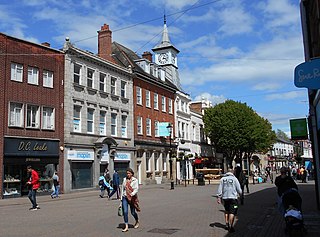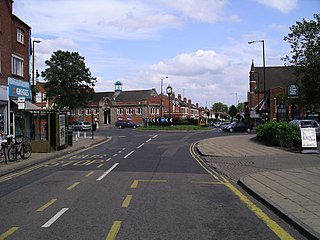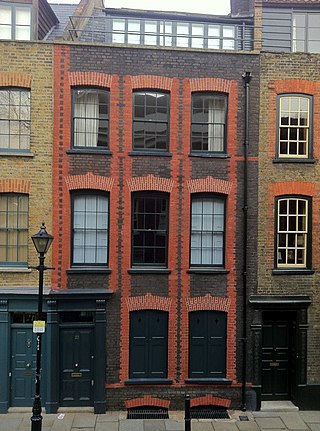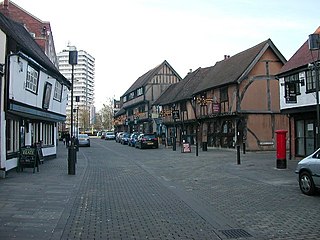Gallery
- A topshop in Bedworth
- Cash's Topshops, Coventry
- Cash's Topshops, Coventry
A topshop or top-shop is a design of building specific to Coventry, Bedworth and Nuneaton in the English Midlands, of the 18th and 19th and early 20th centuries. A topshop has three storeys. It is unusual in that the lower two floors are living accommodation, and that the top floor is a workshop containing a weaver's loom. The windows on the top floor are larger than those on the lower two, to let in more light.
The idea of the topshop may have originated locally. Huguenot refugees from France had settled in Coventry and Bedworth. Some were silk weavers. They adopted the Jacquard loom, invented in France in 1804. [1] Coventry and Bedworth became known for their ribbon weavers. That trade required close attention to detail; and therefore, in times before artificial lighting, the best possible use of daylight. The lower floors in a topshop had to be reinforced to support the weight of the loom. [2] [3] [4] [5]
The idea was also taken up by local watchmakers. [6]
The best surviving example of topshops may be at Cash's former factory in Coventry - "Cash's Topshops". At that site, a beam engine supplied power by lineshaft to a community of topshop weavers. [1] [7] Other examples in Coventry may be found on Far Gosford Street. [3]
Some surviving topshops are listed buildings. [8] [9]

Coventry is a cathedral city and metropolitan borough in the West Midlands county, in England, on the River Sherbourne. Coventry had been a large settlement for centuries. Founded in the early Middle Ages, its city status was formally recognised in a charter of 1345. The city is governed by Coventry City Council.

Weaving is a method of textile production in which two distinct sets of yarns or threads are interlaced at right angles to form a fabric or cloth. Other methods are knitting, crocheting, felting, and braiding or plaiting. The longitudinal threads are called the warp and the lateral threads are the weft, woof, or filling. The method in which these threads are interwoven affects the characteristics of the cloth. Cloth is usually woven on a loom, a device that holds the warp threads in place while filling threads are woven through them. A fabric band that meets this definition of cloth can also be made using other methods, including tablet weaving, back strap loom, or other techniques that can be done without looms.

Nuneaton is a market town in the borough of Nuneaton and Bedworth in Warwickshire, England, located adjacent to the county border with Leicestershire to the north-east. Nuneaton's population at the 2021 census was 88,813, making it the largest town in Warwickshire. Nuneaton's larger urban area, which also includes the large adjoining villages of Bulkington and Hartshill had a population of 99,372 in the 2021 census.

Bedworth is a market town in the borough of Nuneaton and Bedworth, Warwickshire, England. It is situated between Coventry, 6 miles to the south, and Nuneaton, 3 miles (5 km) to the north.

Earlsdon is a residential suburb and electoral ward of Coventry, England. It lies approximately one mile to the southwest of Coventry City Centre. It is the birthplace of aviation pioneer Frank Whittle.

Bulkington is a large village and former civil parish near Bedworth, in the Nuneaton and Bedworth district of Warwickshire, England. In the 2011 census the ward had a population of 6,146 decreasing slightly to 6,080 at the 2021 census. It is located around 6 miles (10 km) northeast of Coventry, just south of the town of Nuneaton, east of Bedworth and 5 miles (8 km) southwest of Hinckley. Despite historically having stronger links with Bedworth, Bulkington forms part of the Nuneaton Urban Area. Bulkington was mentioned in the Domesday Book as Bochintone, meaning "estate associated with a man called Bulca".
TOPSHOP is a British fast-fashion company, which specialises in women's clothing, shoes and accessories. It was part of the Arcadia Group, controlled by Sir Philip Green, but went into administration in late 2020 before being purchased by ASOS on 1 February 2021. It now operates via the ASOS website and app, as well as being sold in Nordstrom stores in the US on Nordstrom.com. TOPSHOP previously had around 510 shops worldwide.

Coventry, a city in the West Midlands, England, grew to become one of the most important cities in England during the Middle Ages due to its booming cloth and textiles trade. The city was noted for its part in the English Civil War, and later became an important industrial city during the 19th and 20th centuries, becoming the centre of the British bicycle and later motor industry. The devastating Blitz in 1940 destroyed much of the city centre, and saw its rebuilding during the 1950s and 60s. The motor industry slumped during the 1970s and 80s, and Coventry saw high unemployment. However, in the new millennium the city, along with many others saw significant urban renaissance and in 2017 it was announced that the city had been awarded the title of 2021 UK City of Culture.

Coventry South is a constituency represented in the House of Commons of the UK Parliament since 2019 by Zarah Sultana of the Labour Party.

The Coventry to Nuneaton Line is a railway line linking Coventry and Nuneaton in the West Midlands of England. The line has a passenger service. It is also used by through freight trains, and freight trains serving facilities on the route.

Fournier Street, formerly Church Street, is a street of 18th-century houses in Spitalfields in the East End of London. It is in the London Borough of Tower Hamlets and runs between Commercial Street and Brick Lane. The street is named after a man of Huguenot extraction, George Fournier.

The Ropewalk Shopping Centre is a shopping centre in Nuneaton, Warwickshire, England. It has a glass roof, two floors retail stores, including high street retailers, and also a car park.

A weavers' cottage was a type of house used by weavers for cloth production in the putting-out system sometimes known as the domestic system.
Midlands 2 West (South) is a level seven English rugby union league and level two of the Midlands League, made up of teams from the southern part of the West Midlands region including Herefordshire, parts of Birmingham and the West Midlands, Warwickshire and Worcestershire, with home and away matches played throughout the season. When this division began in 1992 it was known as Midlands West 1, until it was split into two regional divisions called Midlands 3 West (North) and Midlands 3 West (South) ahead of the 2000–01 season. Further restructuring of the Midlands leagues ahead of the 2009–10 season, lead to the current name of Midlands 2 West (South).

Cash's, or J. & J. Cash Ltd., is a company in Coventry, England, founded in 1846, that manufactures woven name tapes and other woven products and is known for formerly making ribbons.

Coventry Corporation Tramways operated a tramway service in Coventry, England, between 1912 and 1940.

Congleton, Macclesfield, Bollington and Stockport, England, were traditionally silk-weaving towns. Silk was woven in Cheshire from the late 1600s. The handloom weavers worked in the attic workshops in their own homes. Macclesfield was famous for silk buttons manufacture. The supply of silk from Italy was precarious and some hand throwing was done, giving way after 1732 to water-driven mills, which were established in Stockport and Macclesfield.

Spon Street is an historic street in central Coventry, in the West Midlands of England. The street was once part of a route that ran from Gosford to Birmingham – a route which remained intact until the 1960s. During the construction of Coventry's Inner Ring Road, built to relieve traffic on the narrow city centre streets, Spon Street was cut in half and the route severed.
The Warwickshire Rugby Football Union is a governing body for rugby union in part of The Midlands, England. The union is the constituent body of the Rugby Football Union for the city of Coventry and the county of Warwickshire. The current president is Yorkie Kinmond of the Earlsdon Rugby Club.

Gosford Street is one of Coventry's most historic streets, located on the edge of the city centre, just beyond the inner ring road. Far Gosford Street is one of the few streets in Coventry that survived modernization, dilapidation and the Blitz. It has 'Gosford Gate' roundabout to its west, Sky Blue Way relief road to its north, Gosford Green to its east and residential terraced street to its south, since the early 20th century.